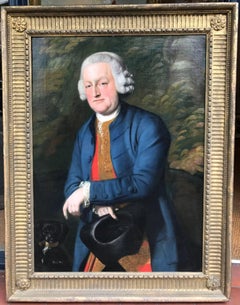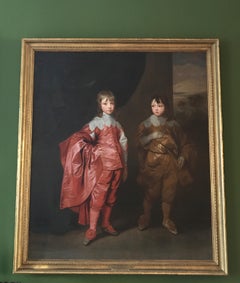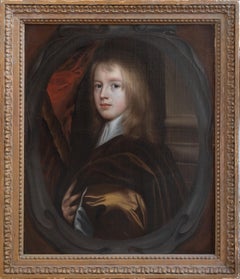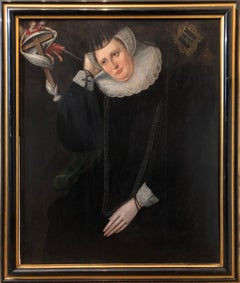Want more images or videos?
Request additional images or videos from the seller
1 of 11
Thomas HickeyOil Painting Portrait of the oboist John Parke (1745–1829)c.1790
c.1790
$33,065.31List Price
About the Item
- Creator:Thomas Hickey (1741-1824, Irish)
- Creation Year:c.1790
- Dimensions:Height: 57 in (144.78 cm)Width: 46 in (116.84 cm)
- Medium:
- Movement & Style:
- Period:
- Condition:
- Gallery Location:London, GB
- Reference Number:1stDibs: LU67334123872
About the Seller
5.0
Vetted Professional Seller
Every seller passes strict standards for authenticity and reliability
Established in 1990
1stDibs seller since 2017
42 sales on 1stDibs
Typical response time: Several days
Authenticity Guarantee
In the unlikely event there’s an issue with an item’s authenticity, contact us within 1 year for a full refund. DetailsMoney-Back Guarantee
If your item is not as described, is damaged in transit, or does not arrive, contact us within 7 days for a full refund. Details24-Hour Cancellation
You have a 24-hour grace period in which to reconsider your purchase, with no questions asked.Vetted Professional Sellers
Our world-class sellers must adhere to strict standards for service and quality, maintaining the integrity of our listings.Price-Match Guarantee
If you find that a seller listed the same item for a lower price elsewhere, we’ll match it.Trusted Global Delivery
Our best-in-class carrier network provides specialized shipping options worldwide, including custom delivery.You May Also Like
Angelic Cherubs with Classical Figure in Wilderness Finely Painted Preparatory
Located in Cirencester, Gloucestershire
Figure with Cherubim in Wilderness
Italian School, 17th century
oil painting on wood panel
framed 13 x 11 inches
condition: overall for its age very good, though the work is most likely a preparatory...
Category
17th Century Old Masters Figurative Paintings
Materials
Oil, Wood Panel
$2,865 Sale Price
20% Off
H 13 in W 11 in D 1 in
French Old Master The Garden of Gethsemane Unusual Shape Panel
Located in Cirencester, Gloucestershire
Artist/ School: French School, 18th century
Title: The Garden of Gethsemane
Medium: oil painting on wooden panel, unframed.
painting: measurem...
Category
18th Century Old Masters Figurative Paintings
Materials
Oil
$1,433 Sale Price
86% Off
H 16 in W 24 in
Fine Antique Classical Nude Draped in Robes Dancing with Dog Gold Background
Located in Cirencester, Gloucestershire
Artist/ School: Italian School, 19th century
Title: Classical nude draped in robes with dancing dog. The work looks as though it might have been a ceiling...
Category
19th Century Old Masters Nude Paintings
Materials
Oil, Canvas
$1,378 Sale Price
20% Off
H 35 in Dm 27 in
Mary & Jesus, 18th Century French Old Master oil painting on canvas
Located in Cirencester, Gloucestershire
Artist/ School: French School, 18th century
Title: Mary and Jesus
Medium: oil on canvas, framed
Framed: 17 x 14.5 inches
Canvas: 16 x 12.75 inches
Provenance: private collection...
Category
18th Century Old Masters Figurative Paintings
Materials
Oil
$2,205 Sale Price
20% Off
H 17 in W 14.5 in
1600's Flemish Old Master Oil Painting The Virgin & Child Mastertpiece Work
Located in Cirencester, Gloucestershire
The Virgin & Child
Flemish School, circa 1600
circle of Cornelis van Cleve (Flemish c. 1520-1614),
oil painting on canvas
canvas: 37 x 30 inches
provenance: private collection, Paris...
Category
Early 17th Century Old Masters Portrait Paintings
Materials
Canvas, Oil
$9,037 Sale Price
54% Off
H 44 in W 36 in D 1 in
Fine 18th Century English Portrait of Aristocratic Gentleman Huge Oil Painting
Located in Cirencester, Gloucestershire
Portrait of an Aristocratic English Gentleman
circle of Thomas Hudson (British (1701-1779)
oil on canvas, framed
framed: 53.5 x 45 inches
painting: 45 x 40 inches
provenance: private...
Category
18th Century Old Masters Portrait Paintings
Materials
Oil
$3,306 Sale Price
20% Off
H 53.5 in W 45 in
Fine Large 17th/ 18th Century English Portrait of Mr. Gilbert Charity Founder
Located in Cirencester, Gloucestershire
Portrait of Mr. Gilbert (believed to be the founder of 'Gilberts Charity, Bridgwater, Somerset)
English School artist, late 17th/ early 18th century
oil...
Category
Late 17th Century Old Masters Portrait Paintings
Materials
Oil, Canvas
$2,205 Sale Price
20% Off
H 30 in W 25 in
Large 17th Century Dutch Old Master Oil Painting on Wood Panel Biblical Scene
Located in Cirencester, Gloucestershire
Biblical Figures, Large Gathering around Christ?
Dutch Old Master, early 17th century
oil painting on wood panel, stuck on velvet backing board
velvet board: 27 x 29 inches
board: 25.5 x 26 inches
provenance: private collection, France
condition: good and sound condition, obvious old panel...
Category
Early 17th Century Old Masters Figurative Paintings
Materials
Oil, Wood Panel
$3,747 Sale Price
20% Off
H 27 in W 29 in
Large 1700's Italian Oil Painting on Canvas Portrait of a Clerical Gentleman
Located in Cirencester, Gloucestershire
Portrait of a Clerical Gentleman
Italian artist, mid 18th century
Circle of Giovanni Battista Carboni (1725-1790)
oil on canvas, unframed
canvas: 26 x 22 inches
provenance: private c...
Category
Mid-18th Century Old Masters Portrait Paintings
Materials
Oil, Canvas
$1,102 Sale Price
20% Off
H 26 in W 22 in
Fine Dutch Old Master Large Oil Painting Portrait Gentleman in Ruff Collar Robes
Located in Cirencester, Gloucestershire
Portrait of a Gentleman in Ruff Collar and Robes
Dutch School, 18th century
oil on canvas laid over panel, unframed
board: 28.5 x 24 inches
provenance: private collection
condition: ...
Category
Mid-20th Century Old Masters Portrait Paintings
Materials
Oil
$2,738 Sale Price
20% Off
H 28.5 in W 23 in
More From This Seller
View All18th Century Oil Painting Portrait of Phillip, 6th Viscount Wenman.
By Nathaniel Dance-Holland
Located in London, GB
Sir Nathaniel Dance-Holland (1750-1811) was an English portrait painter and one of the founding members of the Royal Academy in 1768. Justly celebrated in his lifetime he won several...
Category
Late 18th Century Old Masters Portrait Paintings
Materials
Oil
Double Portrait Oil Painting Brothers George, 2nd Duke Buckingham & Lord Francis
By (After) Anthony Van Dyck
Located in London, GB
Aftrer Anthony VAN DYCK - maybe Studio (1599, Antwerp – 1641, London) Flemish
Double Portrait of George Villiers, 2nd Duke of Buckingham (1628-1687) & Lord Francis Villiers (1629-1648)
Oil on Canvas
170 x 147 cm
Anthony Van Dyck (1599-1641)
No painter has done more to define an era than Anthony van Dyck. He spent only seven and a half years of his short life (1599- 1641) in England. He grew up in Antwerp, where his precocious talent was recognised by Peter Paul Rubens, the greatest painter of his age. He worked in Rubens’s studio and imitated his style as a religious artist, painting biblical scenes redolent of the lush piety of the counter-reformation. But soon he was on the move. In 1620, he visited London for a few months, long enough to paint a history picture, The Continence of Scipio, for the royal favourite, George Villiers, Marquess of Buckingham, and a portrait of his other English patron, the great art collector, Thomas Howard, 2nd Earl of Arundel.
After a stint in Italy, making imposing portraits of the wealthy aristocracy and sketching and copying works by Titian, he returned to the Spanish Netherlands in 1627, becoming court artist to Archduchess Isabella before departing for The Hague in 1631 to paint the Dutch ruler Frederick Henry, Prince of Orange. Charles I’s invitation in 1632 led Van Dyck back to London where he was knighted, paid an annual salary of £200 and installed in a house in Blackfriars with a special jetty at which the royal barge might tie up when the King was visiting his studio. By this time Van Dyck was recognised as the leading court painter in Europe, with Velazquez at the court of Philip IV of Spain his only rival. He also excelled as a superbly observant painter of children and dogs.
Van Dyck’s notoriety in depicting children led to the introduction of groups of children without their parents as a new genre into English painting (amongst other new genres).
For the next 300 years, Van Dyck was the major influence on English portraiture. Nearly all the great 18th Century portraitists, from Pompeo Batoni and Allan Ramsay to Thomas Gainsborough and Joshua Reynolds, copied Van Dyck’s costumes, poses and compositions.
George Duke of Buckingham & his brother Francis Villiers
Painted in 1635, this double portrait was originally commissioned by Charles I, who raised the two brothers after their father, George Villiers, was assassinated in 1628. Together with their sister, Lady Mary Villiers, they enjoyed the King’s favour absolutely. Francis whose absolute ‘inimitable handsomeness’ was noted by Marvell (who was killed in a skirmish near Kingston upon Thames). The young duke who commanded a regiment of horse at the Battle of Worcester, remained closely associated with Charles II, held a number of high offices after the Restoration and was one of the most cynical and brilliant members of the King’s entourage, immortalised as ‘Zimri’ in Dryden’s Absalom and Achitopbel. As a young man he had sold his father’s great collection of pictures in the Spanish Netherlands, many of them to the Archduke Leopold Willhelm.
Painted for Charles I and placed near the portrait of their sister in the Gallery at St James’ Palace. The handling of both costumes is very rich, and the heads are very carefully and sensitively worked. That of the younger boy in particular is more solidly built up than the lower part of the figure. A preparatory drawing for the younger boy is in the British Museum.
There are copies at, e.g., Highclere Castle...
Category
17th Century Old Masters Portrait Paintings
Materials
Oil
17th Century Oil Painting Portrait of a Young English Boy
By Gerard Soest
Located in London, GB
Gerard SOEST (1600 - 1681)
Portrait of a Young Boy
oil on canvas
35.5 x 30.5 inches inc. frame
Gerard Soest (circa 1600 – 11 February 1681), also known as Gerald Soest, was a portra...
Category
17th Century Old Masters Portrait Paintings
Materials
Oil
Lady Dormore - A 16th Century Portrait of a key member of Shakespeare's England
Located in London, GB
Lady Dormer, Mary Browne
c. 1592
oil on panel
35 x 29 inches, unframed;
41 x 34.75 inches, inc. frame
Inscribed 'Lady Dormore'
Mary married Henry Wriothesley, 2nd Earl of Southampton who gave birth to Henry Wriothesley, 3rd Earl of Southampton - one of the great figures in Shakespears"s circle and founder of the Virginia company, developers of Virginia USA.
Henry Wriothesley, born 6 October 1573 at Cowdray House, Sussex, was the only son of Henry Wriothesley, 2nd Earl of Southampton, by Mary Browne, the only daughter of Anthony Browne, 1st Viscount Montague, and his first wife, Jane Radcliffe.[5] He had two sisters, Jane, who died before 1573, and Mary (c. 1567 – 1607), who in June 1585 married Thomas Arundell, 1st Baron Arundell of Wardour.[6]
After his father's death, Southampton's mother married firstly, on 2 May 1595, as his second wife, Sir Thomas Heneage (d. 17 October 1595), Vice-Chamberlain of the Household, and secondly, between 5 November 1598 and 31 January 1599, Sir William Hervey. She died in November 1607.[7]
Early life
When his father died on 4 October 1581 Southampton inherited the earldom and landed income valued at £1097 6s per annum. His wardship and marriage were sold by the Queen to her kinsman, Charles, Lord Howard of Effingham, for £1000. According to Akrigg, Howard then "entered into some further agreement, of which no documentation can now be found, which transferred to Lord Burghley personally the custody and marriage of the young Earl, but left Howard holding his lands", and late in 1581 or early in 1582 Southampton, then eight years of age, came to live at Cecil House in the Strand.[8]
In October 1585, at age twelve, Southampton entered St John's College, Cambridge,[9] graduating M.A. on 6 June 1589.[10] His name was entered at the Gray's Inn legal society before he left the university, and he was admitted on 29 February 1588.[11]
On Southampton's 16th birthday, 6 October 1589, Lord Burghley noted Southampton's age in his diary, and by 1590 Burghley was negotiating with Southampton's grandfather, Anthony Browne, 1st Viscount Montague, and Southampton's mother, Mary, for a marriage between Southampton and Lord Burghley's eldest granddaughter, Elizabeth Vere, daughter of Burghley's daughter, Anne Cecil, and Edward de Vere...
Category
16th Century Old Masters Figurative Paintings
Materials
Oil
C19th Portrait Princesse de Joinville of Brazil - Spectacular fit for a palace
By Henri d'Ainecy Montpezat
Located in London, GB
Portrait of Princess de Joinville riding a Bay Horse
Henri d’Aincy, Le Comte Monpezat (French 1817-1859)
Painted circa 1837-9
oil on canvas
113 x 92 inches (including frame)
92 x 70 inches (unframed)
Provenance – from a private royal collection
This magnificent portrait depicts Princess de Joinville, the daughter of Pedro I, Emperor of Brazil and the King of Portugal. Through her illustrious family she was directly related Alexander III and Nicholas II of Russia and the Russian royal family, as well as to many of the great ruling families of Europe.
The work clearly confirms Monpezat as one of the most accomplished equestrian portrait painters in France in the early nineteenth century. In terms of scale, quality and dramatic power, it must surely be considered amongst his finest works. The stance of the powerful thoroughbred - in half rear - emphasises the calm nature and courage of the Princess.
Francisca of Brazil (1824-98) married a son of Louis Philippe I, the King of the French, and had three children. Born at the Imperial Palace of Saint Christopher, her youngest brother was the future Pedro II...
Category
1830s Old Masters Portrait Paintings
Materials
Oil
$292,265 Sale Price
20% Off
Free Shipping
16th Century Italian Renaissance Old Master Portrait of a Procuratore
By Jacopo Bassano
Located in London, GB
Jacopo BASSANO (c. 1510-1592, Italian)
Portrait of a Procuratore
Oil on canvas
30 ¼ x 26 inches (including frame)
Provenance: Lucien Bonaparte’s Collection (as Portrait of Doge Priuli, Tiziano); Rich-mond, Virginia Museum, Portrait of Doge Lorenzo Priuli.
The painting is a portrait of a man half-length, on a black background. It is a three-quarter portrait, according to a custom very common in the genre of portraiture in sixteenth century. The man is wearing a decorated...
Category
16th Century Old Masters Portrait Paintings
Materials
Oil
$242,635 Sale Price
20% Off
Free Shipping
Recently Viewed
View AllMore Ways To Browse
Avon Antique
Duke Of Cumberland
Stratford Upon Avon
Thomas Hickey
John Dryden
John F Kennedy Painting
Lace Dress Painting
Lord Nelson Painting
Mongolian Oil Painting
Native American Chief Paintings
Officer 18th Century
Oil Painting King Louis
Oil Portrait Woman 1920s
Painting Of Bourbon
Philippe Mercier
Portrait Antique Pre 1900 Paintings
Portrait James Ii
Portrait Tsar



